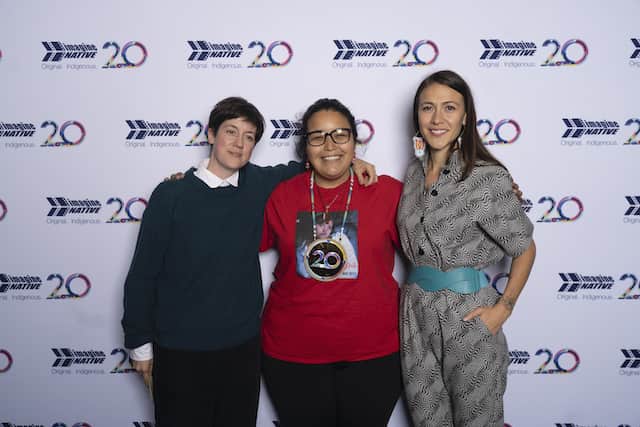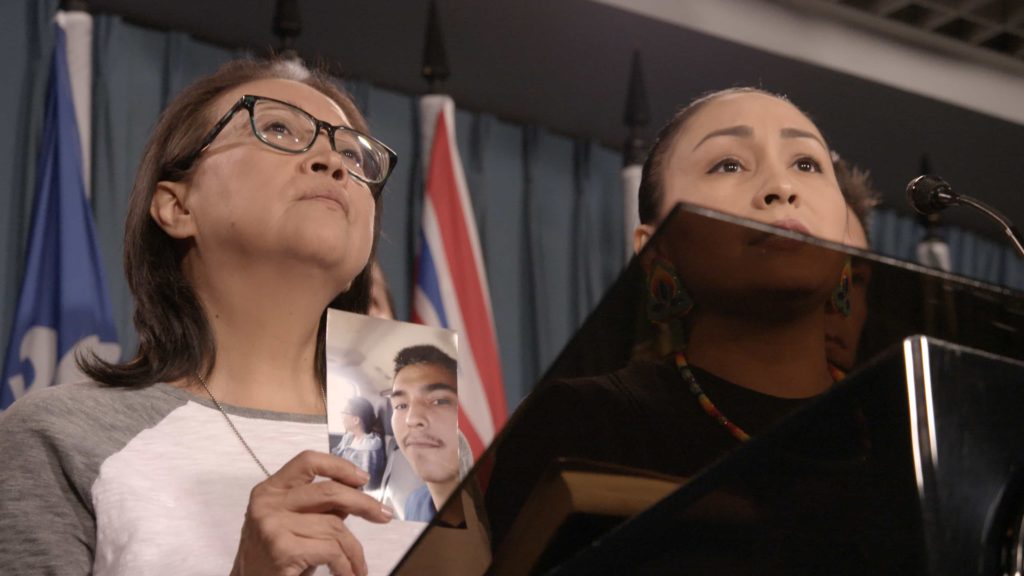imagineNATIVE is all about good medicine.
At the awards ceremony for the 20th imagineNATIVE Film and Media Arts Festival this year, Cree artist Kent Monkman – while giving out an award named in his honour – quipped that the festival was getting old, old enough to have sex. “But let’s not go there,” he said with a wink.

The laughter that ensued was already familiar by that point of the nearly week-long event, not just because the ceremony was hosted by multi-talented Anishinaabe comedian, commentator and media producer Ryan McMahon, but because laughter is good medicine. And imagineNATIVE (iN) is all about good medicine.
Film festivals are strange things, convened as they are so often by sometimes coalescing, sometimes contradicting forces of business, art, community and social engagement. They gather creative individuals and those who appreciate and champion their work from the far corners of the world for intensely condensed periods of time with a mandate to celebrate and support the art and business of filmmaking.
In this regard, iN is no different – industry talks, parties, screenings, micro-meetings, art crawls and business lunches fill the festival’s six days with dynamism, connectivity and opportunity. Yet iN is very different from its cousins in the festival family, precisely because it feels so much like family for those fortunate enough to partake in its annual gatherings.
This edition of iN was the biggest yet and was filled with laughter, love, collaboration, support and respect. All words that help define a healthy, thriving community of creatives pushing boundaries and blasting through the bedrock of tired tropes and conventions established by colonial auteurs, institutions and financiers.
While the presence of TD Bank and Netflix reminded us of the need to find support for media arts in this country beyond problematic corporate partners, iN has a much homier, grassroots culture compared to larger, more commercially concerned festivals. This ethos makes the business side of film and media more human and humane.
The Hopi artist Victor Masayesva, Jr, speaking on the Worn Paths, New Paths panel, wryly noted that once one does it for money, trouble follows. Abenaki trailblazer Alanis Obomsawin responded to the same question of why she keeps making films with, “I do it for my people, of course.”
With 160 films and media artworks on exhibition, audiences found an astounding range of creative expression, cultural sovereignty and social resonance on screen.
The festival opened with one of my three favourite “fiction” films on offer, Zacharias Kunuk’s breathtaking One Day in the Life of Noah Piugatuk, a film that is doing its part to slow the frenzied pace of mainstream cinema’s average shot length. In its quietly contemplative set-up, the film may seem at first to be an innocuous encounter on the ice in Kapuivik (formerly known as Baffin Island) in 1961, but soon becomes an intimate exchange between a colonizing settler and an Inuk man who refuses to be settled.
The determined battle of wills that ensues exposes the dogged determinism of white settlers to engage in wholesale denial of Indigenous rights, desires and experiences. It is not an information-rich film, but Kunuk and the team behind the project carefully focus on this one tiny moment as illustrative of thousands of other moments that we are left to imagine having happened under Canadian colonialism. It is a slow-burn cinematic force that is based on real-life events and ends unexpectedly, tearing us emotionally out of the longer history into the more recent past.
This year’s iN had so many fiction features it was difficult to choose among them. There were shorts and documentaries, and many media artworks (from video games to podcasts to VR pieces) on display in the iNDigital Space in the TIFF Bell Lightbox.
Jeff Barnaby’s newest, Blood Quantum, imagines a world where non-Indigenous people turn into zombies and Indigenous peoples are immune to the virus. It’s pure Barnaby in its gory depiction of violence in a colonial context and a community banding together against yet another settler-led threat. Barnaby even pays homage to Obomsawin’s ground-breaking classic Kanehsatake: 270 Years of Resistance with the staging of a creepy, ghoulish standoff stare-down between settler and Indigenous warrior that recalls the iconic image of Mohawk warrior Brad Larocque and Canadian soldier Patrick Cloutier associated with her 1993 documentary.
Mohawk Shelley Niro’s The Incredible 25th Year of Mitzi Bearclaw follows a city-dwelling, rebellious Indigenous woman (played with a feminist vitality by MorningStar Angeline), who leaves behind her urban life to care for her sick mother in her small, nature-rich home community. The film depicts the often-hilarious goings on of inner-community rivalry and character irreverence.
Identity and belonging are put into crisis mode in Sonia Bonspille-Boileau’s (Mohawk) outstanding, brilliantly acted and evocatively written drama Rustic Oracle. Told from the unflinching perspective of eight-year-old Ivy (played by Lake Kahentawaks Delisle, who gives the best performance by a child actor in a feature film in recent memory), the film captures the trauma and anguish of a family reeling from the recent disappearance of yet another young Indigenous woman, Ivy’s 16-year-old sister Heather (played with a ferocity of presence by McKenzie Deer Robinson).
I’ve noticed a tendency in Canadian fiction films for over-writing that I think stems in part from the influence of the country’s robust history of documentary filmmaking. Expository and explanatory storytelling can feel woefully out of place in drama. Rustic Oracle is a powerful film that thankfully bucks that trend, opting instead for understatement and emotionally conveyed scenes. Bonspille-Boilaeu drew on three real-life stories for the writing of Rustic Oracle. The result is a moving, unforgettable drama that adds human complexity and emotional depth to the ongoing MMIWG crisis.
My third top fiction pick is the uncompromising and creatively daring drama The Body Remembers When the World Broke Open, directed by Elle-Maíjá Tailfeathers (Blackfoot/Sámi) and Kathleen Hepburn, which was named the festival’s best feature film.

I was instantly swallowed whole by the world Tailfeathers and Hepburn create, a rendering of a real-life experience remembered cinematically by Tailfeathers. Shot on rich 16mm with deep blue and grey tones that invoke the cool, damp and alienating feeling of a wet Vancouver street, somehow The Body Remembers creates the cinematic conditions in which a feeling of human comfort pervade a menacing undercurrent of traumatic violence.
The story is about a woman encountering and helping another woman, both Indigenous, who has experienced violence at the hands of her abusive boyfriend. The film is told only from the women’s perspectives. We never see the boyfriend (though we hear him), which allows for the building of a creative and political space of female empowerment.
It is no surprise this stellar work is winning both audiences and awards. The Body Remembers is a film about the experience of Indigenous women living in regimes of trauma. But it is also artwork about resilience, mutual aid, love and kinship. Its impeccable lensing, deft direction and outstanding performances make it a must see.

On the documentary docket, Tasha Hubbard’s (Cree) film deservedly took the Moon Jury and Audience Choice prizes. nîpawistamâsowin: We Will Stand Up is a resonant indictment of Canada’s justice system. In this very personal, emotional and political feature documentary, Hubbard reveals the racism that still informs Canada’s state institutions. The film documents the acquittal of white Saskatchewan farmer Gerald Stanley who shot and killed Colten Boushie, the 22-year-old Cree man, in 2016. For the many who feel outraged at the verdict of the non-Indigenous jury, Hubbard’s thoughtful, intimate and caring portrait offers a glimmer of hope while looking for answers and demanding justice.
And that’s just a small sampling. Imagine what’s on store for next year’s top festival for Indigenous film and media arts. One last thing: Did I mention the news that imagineNATIVE shorts will now qualify to be included in Oscar submissions? Yet another border crossed and barrier taken down by this fierce, creative community.





